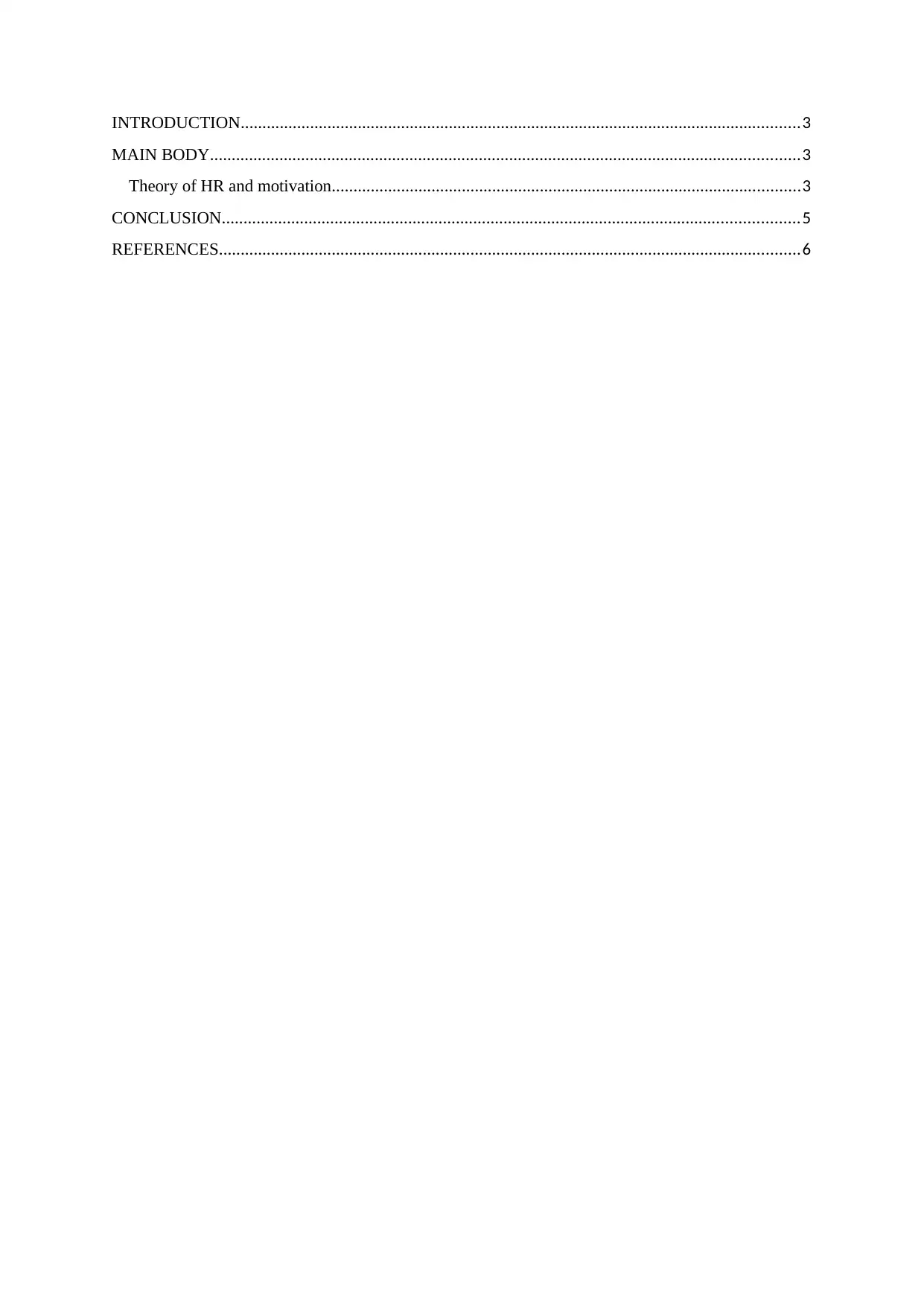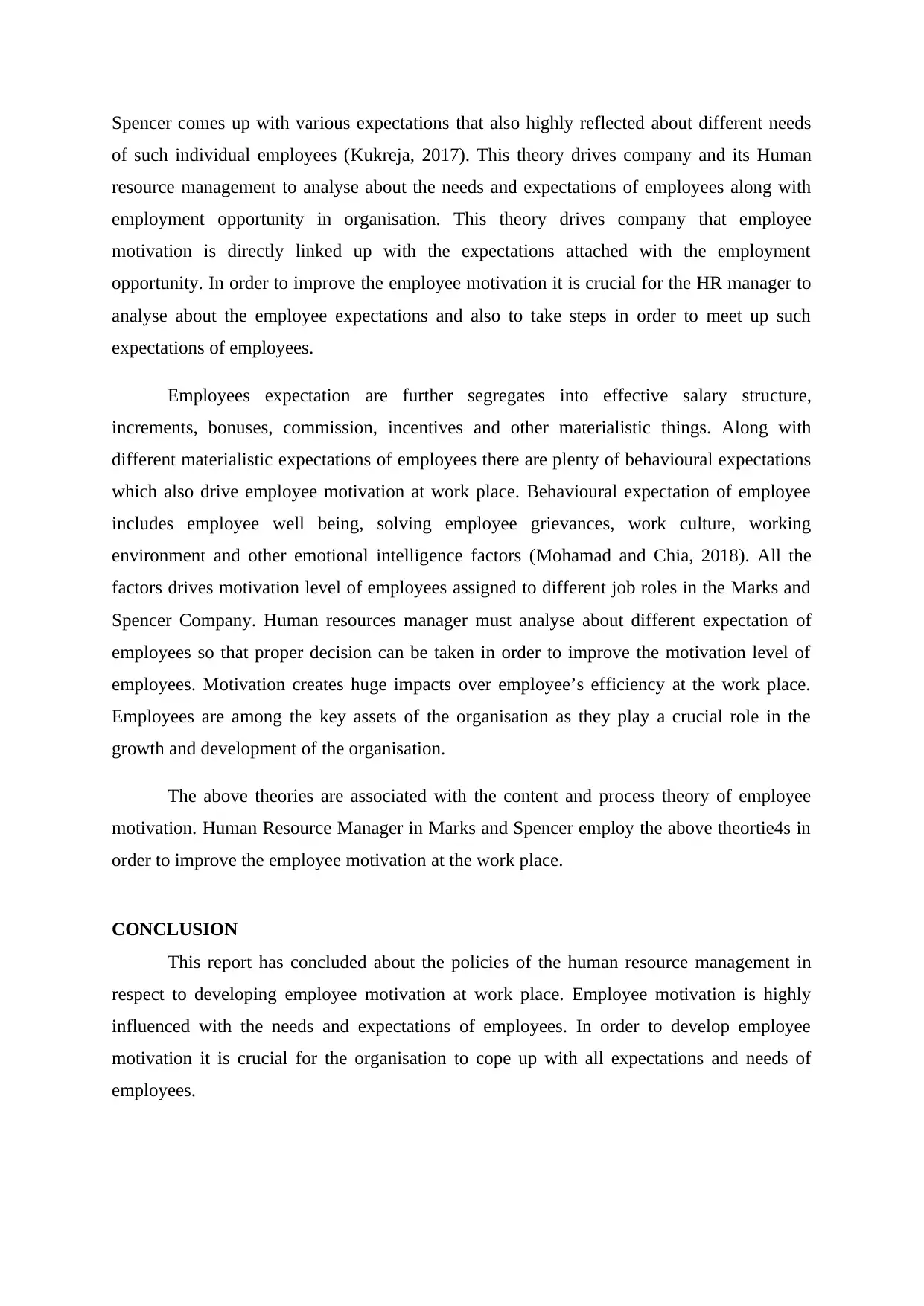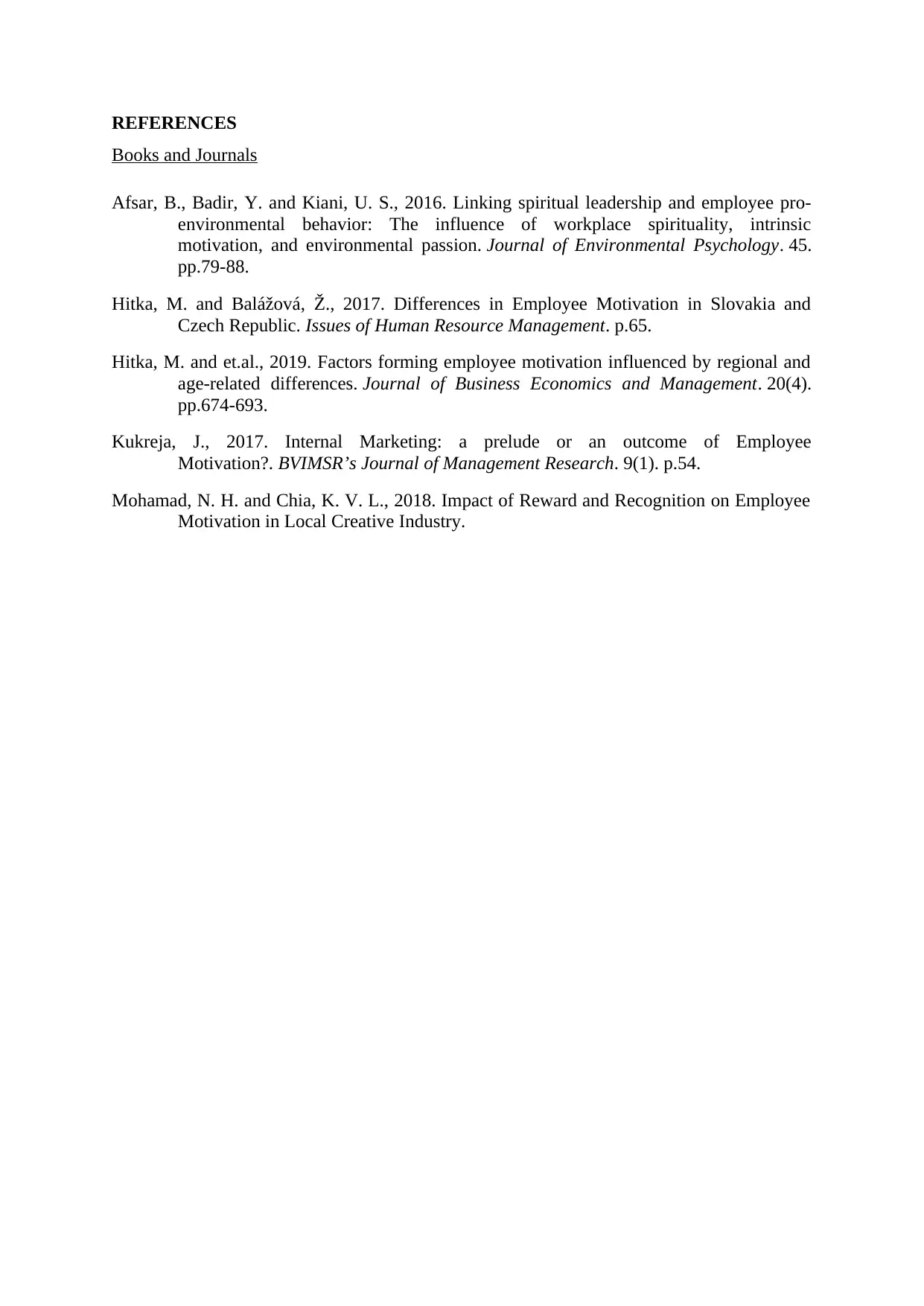Human Resource Management Practices in Marks and Spencer Company
VerifiedAdded on 2023/01/11
|6
|1317
|40
AI Summary
This report discusses the human resource management practices in Marks and Spencer Company, focusing on employee motivation. It explores the theories of HR and motivation, including Maslow's hierarchy of needs and Vroom's expectancy theory. The report concludes that employee motivation is influenced by their needs and expectations.
Contribute Materials
Your contribution can guide someone’s learning journey. Share your
documents today.

Human resources
Table of Contents
Table of Contents
Secure Best Marks with AI Grader
Need help grading? Try our AI Grader for instant feedback on your assignments.

INTRODUCTION.................................................................................................................................3
MAIN BODY........................................................................................................................................3
Theory of HR and motivation............................................................................................................3
CONCLUSION.....................................................................................................................................5
REFERENCES......................................................................................................................................6
MAIN BODY........................................................................................................................................3
Theory of HR and motivation............................................................................................................3
CONCLUSION.....................................................................................................................................5
REFERENCES......................................................................................................................................6

INTRODUCTION
Human resource management is defined as managing the needs of the organisation in
respect to man power at different operation level. This report is based on the case study of
Marks and Spencer Company is respect to its human resource management practices.
Company was established in the year 1884 by Michael Marks and Thomas Spencer.
Company operates its business operations in retail sector. Headquarter of the Marks and
Spencer Company is located in London, United Kingdom. Henceforth, report will emphasis
on human resource management practices applicable in Marks and Spencer Company in
regards to the motivation at the work place.
MAIN BODY
Theory of HR and motivation
Motivation is defined as a process to improve employee’s morale in order to entertain
high level of work efficiency from the operation practices. Management and human resource
department in Marks and Spencer Company implement content and process theory to
motivate company’s employees.
Maslow hierarchy of needs
This theory is a part of the content theory of employee motivation. Maslow hierarchy
of needs is among the key content theories to motivate company’s employees. This theory
interrelate motivation of employees with the needs and requirements of employees. Human
resources are associated with different kinds of requirements that drives them to achieve and
growth in the career. This theory segregates needs of employees into five different parts such
as physiological needs, safety and security, belongingness and love, esteem and self
actualisation.
Physiological needs: Physiological considers as the basic needs of human being in order to
perform employment duty. This need covers employee’s requirements such as food, shelter,
water, sleep and other basic needs of human being (Afsar, Badir and Kiani, 2016). This is
more like minimum requirements that need to get fulfil from the employment at the work
place. It is crucial for the Marks and Spencer Company and human resource department to
meet physiological needs along with providing employment opportunities to employees.
Human resource management is defined as managing the needs of the organisation in
respect to man power at different operation level. This report is based on the case study of
Marks and Spencer Company is respect to its human resource management practices.
Company was established in the year 1884 by Michael Marks and Thomas Spencer.
Company operates its business operations in retail sector. Headquarter of the Marks and
Spencer Company is located in London, United Kingdom. Henceforth, report will emphasis
on human resource management practices applicable in Marks and Spencer Company in
regards to the motivation at the work place.
MAIN BODY
Theory of HR and motivation
Motivation is defined as a process to improve employee’s morale in order to entertain
high level of work efficiency from the operation practices. Management and human resource
department in Marks and Spencer Company implement content and process theory to
motivate company’s employees.
Maslow hierarchy of needs
This theory is a part of the content theory of employee motivation. Maslow hierarchy
of needs is among the key content theories to motivate company’s employees. This theory
interrelate motivation of employees with the needs and requirements of employees. Human
resources are associated with different kinds of requirements that drives them to achieve and
growth in the career. This theory segregates needs of employees into five different parts such
as physiological needs, safety and security, belongingness and love, esteem and self
actualisation.
Physiological needs: Physiological considers as the basic needs of human being in order to
perform employment duty. This need covers employee’s requirements such as food, shelter,
water, sleep and other basic needs of human being (Afsar, Badir and Kiani, 2016). This is
more like minimum requirements that need to get fulfil from the employment at the work
place. It is crucial for the Marks and Spencer Company and human resource department to
meet physiological needs along with providing employment opportunities to employees.

Safety and security: Safety and security is among the key needs associated with the
Physiological needs associated with the human resources in Marks and Spencer Company.
Safety indicates with the protection of employees. It is fundamental right of employees to get
the well secured work place. Safety and security also indicates organisation and HR manager
towards providing healthy work place to all employees (Hitka and Balážová, 2017). In order
to ensure safety and security at work place HR manager needs to cater amenities like
insurance premium of all employees so that proper cure can be catered to employees. Well
designed organization structure is also important in this regards to provide safety and security
to employees.
Belongingness and love: Belongingness and love is more like all employees associated with
the Marks and Spencer Company must feel to be a part of the organisation. It is crucial for
the management in organisation that all employees join the organisation must feel that they
belong to the organisation. Proper treatment of employee’s wellbeing plays an important role
in order to drive employee motivation at work place.
Esteem: In order to motivate employees in company it is crucial for all employees to get
proper treatment and respect at the work place. Respect of employees play an effective role in
improving the wellbeing of employees at work place (Hitka and et.al., 2019). Human
resource department must ensure that all employees are getting proper treatment in the
organisation. Employees in company must get opportunities to speak up the views and the
thoughts.
Self actualisation: Self actualisation is also among the key factor that drives employee
motivation at work place. All employees must get proper opportunities to grow in the
organisation. Growth and development is an important factor which also put impact over
employee sustainability at the work place.
All the above factors indicate about the different elements of content theory that
motivate employees in organisations.
Vroom’s expectancy theory
Vroom’s expectancy theory is a part of the process theory of employee motivation.
This theory emphasis over the expectations of employees associated with the organisation.
Employee expectation plays a key role in order to develop motivation in employees
appointed at different designated positions in organisation. All employees joins Marks and
Physiological needs associated with the human resources in Marks and Spencer Company.
Safety indicates with the protection of employees. It is fundamental right of employees to get
the well secured work place. Safety and security also indicates organisation and HR manager
towards providing healthy work place to all employees (Hitka and Balážová, 2017). In order
to ensure safety and security at work place HR manager needs to cater amenities like
insurance premium of all employees so that proper cure can be catered to employees. Well
designed organization structure is also important in this regards to provide safety and security
to employees.
Belongingness and love: Belongingness and love is more like all employees associated with
the Marks and Spencer Company must feel to be a part of the organisation. It is crucial for
the management in organisation that all employees join the organisation must feel that they
belong to the organisation. Proper treatment of employee’s wellbeing plays an important role
in order to drive employee motivation at work place.
Esteem: In order to motivate employees in company it is crucial for all employees to get
proper treatment and respect at the work place. Respect of employees play an effective role in
improving the wellbeing of employees at work place (Hitka and et.al., 2019). Human
resource department must ensure that all employees are getting proper treatment in the
organisation. Employees in company must get opportunities to speak up the views and the
thoughts.
Self actualisation: Self actualisation is also among the key factor that drives employee
motivation at work place. All employees must get proper opportunities to grow in the
organisation. Growth and development is an important factor which also put impact over
employee sustainability at the work place.
All the above factors indicate about the different elements of content theory that
motivate employees in organisations.
Vroom’s expectancy theory
Vroom’s expectancy theory is a part of the process theory of employee motivation.
This theory emphasis over the expectations of employees associated with the organisation.
Employee expectation plays a key role in order to develop motivation in employees
appointed at different designated positions in organisation. All employees joins Marks and
Secure Best Marks with AI Grader
Need help grading? Try our AI Grader for instant feedback on your assignments.

Spencer comes up with various expectations that also highly reflected about different needs
of such individual employees (Kukreja, 2017). This theory drives company and its Human
resource management to analyse about the needs and expectations of employees along with
employment opportunity in organisation. This theory drives company that employee
motivation is directly linked up with the expectations attached with the employment
opportunity. In order to improve the employee motivation it is crucial for the HR manager to
analyse about the employee expectations and also to take steps in order to meet up such
expectations of employees.
Employees expectation are further segregates into effective salary structure,
increments, bonuses, commission, incentives and other materialistic things. Along with
different materialistic expectations of employees there are plenty of behavioural expectations
which also drive employee motivation at work place. Behavioural expectation of employee
includes employee well being, solving employee grievances, work culture, working
environment and other emotional intelligence factors (Mohamad and Chia, 2018). All the
factors drives motivation level of employees assigned to different job roles in the Marks and
Spencer Company. Human resources manager must analyse about different expectation of
employees so that proper decision can be taken in order to improve the motivation level of
employees. Motivation creates huge impacts over employee’s efficiency at the work place.
Employees are among the key assets of the organisation as they play a crucial role in the
growth and development of the organisation.
The above theories are associated with the content and process theory of employee
motivation. Human Resource Manager in Marks and Spencer employ the above theortie4s in
order to improve the employee motivation at the work place.
CONCLUSION
This report has concluded about the policies of the human resource management in
respect to developing employee motivation at work place. Employee motivation is highly
influenced with the needs and expectations of employees. In order to develop employee
motivation it is crucial for the organisation to cope up with all expectations and needs of
employees.
of such individual employees (Kukreja, 2017). This theory drives company and its Human
resource management to analyse about the needs and expectations of employees along with
employment opportunity in organisation. This theory drives company that employee
motivation is directly linked up with the expectations attached with the employment
opportunity. In order to improve the employee motivation it is crucial for the HR manager to
analyse about the employee expectations and also to take steps in order to meet up such
expectations of employees.
Employees expectation are further segregates into effective salary structure,
increments, bonuses, commission, incentives and other materialistic things. Along with
different materialistic expectations of employees there are plenty of behavioural expectations
which also drive employee motivation at work place. Behavioural expectation of employee
includes employee well being, solving employee grievances, work culture, working
environment and other emotional intelligence factors (Mohamad and Chia, 2018). All the
factors drives motivation level of employees assigned to different job roles in the Marks and
Spencer Company. Human resources manager must analyse about different expectation of
employees so that proper decision can be taken in order to improve the motivation level of
employees. Motivation creates huge impacts over employee’s efficiency at the work place.
Employees are among the key assets of the organisation as they play a crucial role in the
growth and development of the organisation.
The above theories are associated with the content and process theory of employee
motivation. Human Resource Manager in Marks and Spencer employ the above theortie4s in
order to improve the employee motivation at the work place.
CONCLUSION
This report has concluded about the policies of the human resource management in
respect to developing employee motivation at work place. Employee motivation is highly
influenced with the needs and expectations of employees. In order to develop employee
motivation it is crucial for the organisation to cope up with all expectations and needs of
employees.

REFERENCES
Books and Journals
Afsar, B., Badir, Y. and Kiani, U. S., 2016. Linking spiritual leadership and employee pro-
environmental behavior: The influence of workplace spirituality, intrinsic
motivation, and environmental passion. Journal of Environmental Psychology. 45.
pp.79-88.
Hitka, M. and Balážová, Ž., 2017. Differences in Employee Motivation in Slovakia and
Czech Republic. Issues of Human Resource Management. p.65.
Hitka, M. and et.al., 2019. Factors forming employee motivation influenced by regional and
age-related differences. Journal of Business Economics and Management. 20(4).
pp.674-693.
Kukreja, J., 2017. Internal Marketing: a prelude or an outcome of Employee
Motivation?. BVIMSR’s Journal of Management Research. 9(1). p.54.
Mohamad, N. H. and Chia, K. V. L., 2018. Impact of Reward and Recognition on Employee
Motivation in Local Creative Industry.
Books and Journals
Afsar, B., Badir, Y. and Kiani, U. S., 2016. Linking spiritual leadership and employee pro-
environmental behavior: The influence of workplace spirituality, intrinsic
motivation, and environmental passion. Journal of Environmental Psychology. 45.
pp.79-88.
Hitka, M. and Balážová, Ž., 2017. Differences in Employee Motivation in Slovakia and
Czech Republic. Issues of Human Resource Management. p.65.
Hitka, M. and et.al., 2019. Factors forming employee motivation influenced by regional and
age-related differences. Journal of Business Economics and Management. 20(4).
pp.674-693.
Kukreja, J., 2017. Internal Marketing: a prelude or an outcome of Employee
Motivation?. BVIMSR’s Journal of Management Research. 9(1). p.54.
Mohamad, N. H. and Chia, K. V. L., 2018. Impact of Reward and Recognition on Employee
Motivation in Local Creative Industry.
1 out of 6
Related Documents
Your All-in-One AI-Powered Toolkit for Academic Success.
+13062052269
info@desklib.com
Available 24*7 on WhatsApp / Email
![[object Object]](/_next/static/media/star-bottom.7253800d.svg)
Unlock your academic potential
© 2024 | Zucol Services PVT LTD | All rights reserved.




